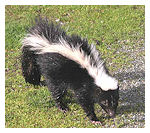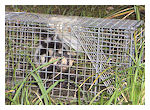General Info
Size: Approximately 20 – 30 inches
Weight: 3 ½ to 10 pounds

There are five species of skunks, striped, spotted, hooded, and two types of hog-nosed skunks. Two full-body stripes that begin at the base of the neck (a white-V look), and the narrow-stripe down the snout distinguish the Striped Skunk. Hooded Skunks, do not have the white-V marking, but do have a group of long white hair that extends from the back of their neck, and also have a fifteen-inch tail. This is about twice the tail length of most Striped Skunks. Hognose Skunks have a long pig-like snout, and their entire back and tail are white, while the lower sides and belly are black. Spotted Skunks have numerous short body-stripes with an extra spot on their forehead, one under each ear, and a white-tipped tail.
Habitat
Skunks are adaptable. They live in a range of open, scrub, wooded, agricultural, and developed areas. Hooded and Hognose Skunks can generally be found in brushy or rocky land areas. They reside near streams or water sources in woodlands, brush, open prairie, and among boulders and rock crevices. Skunks know how to dig their own burrows, but seem to prefer moving into ones built by other animals. In urban areas, they will also nest in houses, walls, beneath buildings, and in wood and rock piles. When it comes to animal control or wildlife control – skunks are animals most homeowners don’t want to mess with.
Damage
In urban areas, skunks may damage gardens and lawns as well as expose humans and pets to several infectious diseases, especially rabies. In rural areas, skunks can cause losses to poultry operations; expose livestock to disease, and at times cause damage to crops. If you have ever had your pet sprayed by a skunk, you know it is best to call Metro Guard at first signs of this animal.
Disease
Skunks are carriers of rabies, but not every skunk is rabid. If an adult skunk seen in the daytime is showing odd behavior such as paralysis, unprovoked aggression, moving in circles, you should call a professional. Skunks are a prime source of rabies in Texas. Human and pet contact with skunks should be avoided.. If you have to handle a skunk, please take all necessary precautions to keep from being bitten, scratched or sprayed. Remember, skunks may also carry fleas and ticks.
Control

When it comes to skunks, there is really no easy way of trapping it yourself. Skunks can spray up to 15 feet and is likely to do so when it feels threatened. Our wildlife experts have extensive training when it comes to skunk trapping. Metro Guard knows exactly where to place the trap. Once trapped, the skunk will be removed carefully and treated in a humane manner. Contact Metro Guard for a free estimate.


Follow Us